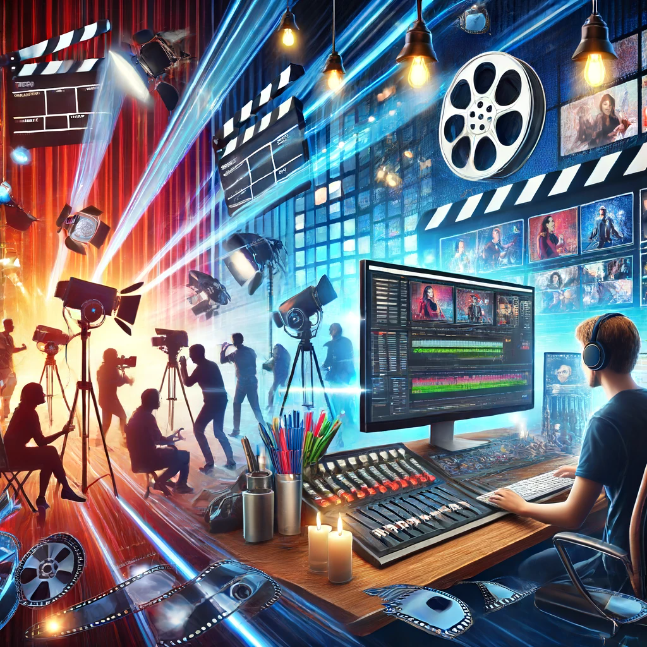Filming and Editing: The Art and Science of Bringing Stories to Life

Filming and editing are the cornerstones of the filmmaking process, transforming written scripts into compelling visual narratives. The journey from script to screen involves meticulous planning, creative vision, and technical expertise. This article delves into the intricacies of filming and editing, exploring the techniques, challenges, and innovations that shape the art of storytelling in cinema.
The Art of Filming
Filming, or cinematography, is the process of capturing moving images on film or digital media. It involves several key elements:
- Pre-Production Planning
- Script Breakdown: Before filming begins, the script is broken down into individual scenes and shots. This includes identifying locations, props, special effects, and any other logistical details.
- Storyboarding: A storyboard is a visual representation of the film’s shots, helping directors and cinematographers visualize each scene. It serves as a blueprint for the shooting process.
- Casting and Rehearsals: Selecting the right actors and conducting rehearsals are crucial steps. Actors must embody their characters and understand the director's vision.
- Camera Work
- Camera Types and Formats: The choice of camera and format (e.g., digital, 35mm film) can significantly impact the film's aesthetic. High-definition digital cameras offer clarity and flexibility, while traditional film cameras provide a classic, textured look.
- Camera Angles and Movements: Different angles and movements (e.g., tracking shots, dolly shots, handheld) create varied visual effects. They can convey emotions, build tension, or highlight important details.
- Lighting: Proper lighting sets the mood and enhances the visual storytelling. Techniques such as three-point lighting, natural lighting, and creative shadows are used to achieve the desired effect.
- Sound and Audio
- On-Set Sound Recording: Capturing clear and high-quality audio during filming is essential. This includes dialogue, ambient sounds, and any specific sound effects required for the scene.
- Sound Design: In post-production, sound design adds layers of audio that enhance the narrative. This can include Foley effects, background scores, and other auditory elements.
The Craft of Editing
Editing is the process of assembling the captured footage into a coherent and engaging narrative. It is where the story truly comes to life.
- Rough Cut
- Footage Review: Editors begin by reviewing all the raw footage, selecting the best takes for each scene. This initial selection forms the foundation of the rough cut.
- Sequencing: The selected clips are arranged in the order specified by the script. This step establishes the film’s basic structure and flow.
- Fine Cut
- Pacing and Rhythm: Editors adjust the pacing and rhythm of the film, ensuring that scenes transition smoothly and maintain the audience's interest. This involves fine-tuning the length of shots and the timing of cuts.
- Continuity: Maintaining continuity ensures that the film appears seamless. Editors check for inconsistencies in visual and audio elements, making necessary corrections.
- Visual Effects: Any required visual effects are added during this stage. This can include CGI, green screen compositing, and other digital enhancements.
- Sound Editing and Mixing
- Dialogue Editing: Ensuring that dialogue is clear and appropriately synced with the visuals. This may involve re-recording certain lines (ADR) or adjusting audio levels.
- Sound Effects: Adding and layering sound effects to enhance the realism and impact of scenes. This includes both diegetic sounds (within the film's world) and non-diegetic sounds (external, like a soundtrack).
- Music and Score: Integrating music to support the narrative and evoke emotions. The score is carefully synchronized with the film to enhance its dramatic effect.
- Mixing: Balancing all audio elements (dialogue, effects, music) to ensure they complement each other and the visuals.
- Color Grading
- Color Correction: Adjusting the color balance of each shot to ensure consistency throughout the film. This can involve correcting lighting issues and matching the color tones of different scenes.
- Creative Grading: Applying color grades to create specific moods or visual styles. For example, a sepia tone might be used for flashbacks, while a cooler blue tone might convey a sense of unease.
Challenges in Filming and Editing
- Budget Constraints
- Filmmaking can be expensive, with costs for equipment, locations, cast, and crew adding up quickly. Budget limitations often require creative solutions and compromises.
- Time Management
- Filming schedules are typically tight, with limited time allocated for each scene. Efficient planning and flexibility are essential to stay on track and meet deadlines.
- Technological Hurdles
- Rapid advancements in technology mean that filmmakers and editors must continually adapt to new tools and techniques. Keeping up with the latest software and hardware can be challenging but also offers new possibilities.
- Creative Differences
- Filmmaking is a collaborative effort, often involving many creative minds. Balancing different visions and ideas requires strong communication and compromise.
Innovations in Filmmaking and Editing
- Digital Filmmaking
- Digital cameras and editing software have revolutionized the industry, making high-quality filmmaking more accessible. Tools like Adobe Premiere, Final Cut Pro, and DaVinci Resolve offer powerful editing capabilities.
- Virtual Production
- Technologies like virtual sets and augmented reality (AR) allow filmmakers to create complex scenes without physical sets. This innovation saves time and costs while expanding creative possibilities.
- AI and Machine Learning
- AI-powered tools assist with various aspects of editing, such as automated color grading, sound enhancement, and even preliminary cuts. These tools speed up the editing process and allow editors to focus on creative decisions.
Filming and editing are the heart of the filmmaking process, transforming scripts into visual masterpieces that captivate audiences. Through meticulous planning, creative vision, and technological innovation, filmmakers bring stories to life, creating experiences that resonate long after the credits roll. The art and science of filming and editing continue to evolve, promising exciting developments and new storytelling possibilities for the future of cinema.



